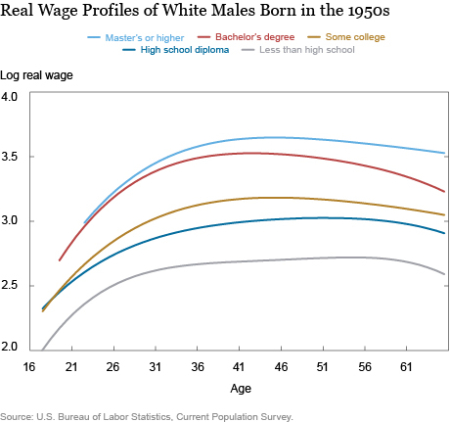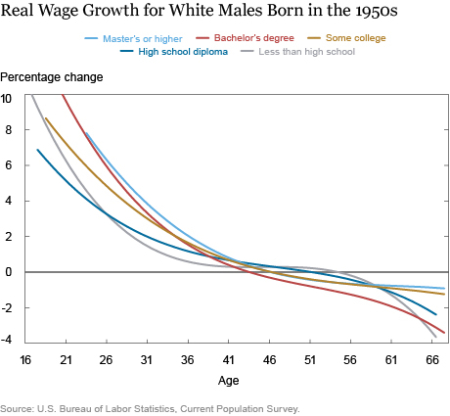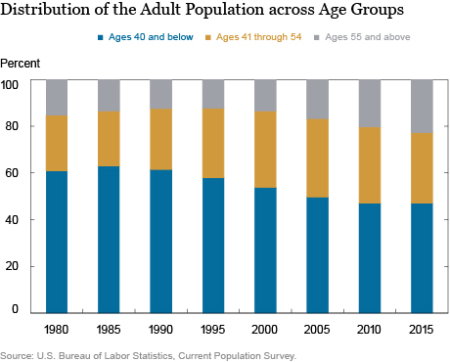Much has been written about the aging of the U.S. population, but the importance of this trend for the economy and its evolution can easily be overlooked. This week, we focus on the aging of the labor force and explore its implications for the behavior of real wage growth. In this first post, we examine estimated real wage profiles of workers and document how their levels and growth rates differ across demographic characteristics such as sex, race/ethnicity, education level, and age. Moreover, we argue that the demographic trends predict a slower pace of real wage growth for an increasing fraction of the workforce. Our second post combines the implied real wage growth rates and changing demographics of the U.S. labor force to derive a “cyclically neutral” aggregate real wage growth series. We show that this series has been steadily declining since the mid-1980s.
To investigate real wage growth patterns, we look at the hourly wage rates of all employed individuals aged sixteen or older in the Current Population Survey (CPS). We use both the CPS Outgoing Rotation Group samples, which provide monthly data from January 1982 through May 2016, and the May Extracts, which provide annual data from 1969 through 1981. Combining these two data sources gives us 12.7 million total observations on individuals, their employment status, and their nominal hourly earnings (if employed). In cases where actual hourly wages are missing, we infer the implied hourly wage using the individuals’ reported “usual” weekly earnings and actual number of hours worked per week. We use the CPI to convert nominal hourly wages to real hourly wages in first-quarter 2014 dollars.
Using the same cohort framework applied in a 2015 Liberty Street Economics post on labor market slack to analyze the effect of changing demographics on the U.S. economy’s employment-to-population ratio, we first restrict our sample to employed individuals who have a reported or imputed wage, which leaves us with 7.6 million observations. We then divide this subsample of individuals into 140 different demographic cohorts based on their decade of birth, sex, race, and educational attainment. For example, white male college graduates born in the 1950s constitute one cohort. Assuming that individuals within a specific demographic cohort have similar life-cycle real wage profiles, we estimate the life-cycle real wage profiles associated with each of these 140 cohorts. Our estimations include cohort-specific year and month effects—with 2008 as the omitted year and January as the omitted month—to control for cyclical and seasonal effects. The resulting profile is best thought of as an expected real wage path, where the controls remove any fluctuations in the real wage associated with seasonality or the business cycle. The chart below shows five of these estimated profiles for white men born between 1950 and 1959, by five levels of education.

These five cohorts display some patterns that are generally consistent across all of our demographic cohorts. Real wage profiles tend to shift up for higher levels of education when other characteristics of the cohort are held constant. The profiles also display an inverted U-shape. Real wages tend to rise early in a worker’s career, flatten out mid-career and then decline as the worker approaches retirement. This inverted U-shape pattern is a well-established feature in the labor economics literature.
Our main focus, however, is on the implied growth rate of real wages as opposed to the level of real wages. Because we are using a log scale to plot the real wage profiles, it is possible to translate the level of real wages into growth rates. Specifically, we can compute the implied real wage growth rates as the slopes of the estimated cohort-specific real wage profiles at a given age. As the slope of the line steepens (flattens) at a point on the profile, real wage growth increases (decreases). At the end when the slope turns downward, real wage growth is negative and the level of real wages is actually falling. The chart below shows the real wage growth rates for the same five cohorts of white men born between 1950 and 1959, by five levels of education.

These five cohorts illustrate a number of important features of the demographic pattern of real wage growth. All five cohorts display rapid real wage growth early in a worker’s career, with positive real wage growth ending when the worker is in his/her forties. This is followed by a period of either flat (high school graduates or less) to declining real wages (some college or more). By age 55, all education categories are, on average, experiencing negative real wage growth. Note, however, that while real wage growth may be similar across the five groups in some periods, there are still underlying differences in the levels of real wages. Consequently, the level of real wages of less educated workers will remain below that of higher educated workers even if they are growing at the same rate.
Labor economists explain the rapid real wage growth early in a worker’s career as a combination of on-the-job learning and better matching of workers to jobs. A large portion is due to job matching as workers change jobs in search of a position that better utilizes their skills. As workers age, the decline in the pace of their real wage growth reflects a diminished incentive to invest in new skills (because their remaining work life is shorter) and fewer job changes (because they have found a good job match).
As a labor force ages, more workers will transition from the fast to the slow or negative real wage growth phases of their careers. Drawing on the patterns we observed in the cohort real wage growth profiles, we divide careers into three life-cycle phases: (1) fast growth, up to age 40, (2) flat growth, ages 41-54, and (3) negative growth, age 55 and older. The next chart shows the distribution over time of the U.S. adult population across these three career phases. The fraction of the U.S. population in the fast real wage growth phase has declined from close to 60 percent in the 1980s to the mid-40 percent range recently. Correspondingly, a greater fraction of the U.S. population is now in the flat and declining life-cycle phases of real wage growth.

So, what does all of this suggest in terms of the behavior of real wage growth since 1980? In Wednesday’s post, we combine the information on the demographic pattern of real wage growth rates with the information on the changing demographics of the U.S. population to construct an economy-wide average real wage growth rate over the last thirty-five years. We show that there has been a meaningful slowdown in this average real wage growth rate as the U.S. population has aged.
Disclaimer
The views expressed in this post are those of the authors and do not necessarily reflect the position of the Federal Reserve Bank of New York or the Federal Reserve System. Any errors or omissions are the responsibility of the authors.
 Robert Rich is an assistant vice president in the Federal Reserve Bank of New York’s Research and Statistics Group.
Robert Rich is an assistant vice president in the Federal Reserve Bank of New York’s Research and Statistics Group.

Joseph Tracy is an executive vice president and senior advisor to the president of the Federal Reserve Bank of New York.
Ellen Fu is a former senior research analyst in the Bank’s Research and Statistics Group.
How to cite this blog post:
Robert Rich, Joseph Tracy, and Ellen Fu, “U.S. Real Wage Growth: Fast Out of the Starting Blocks,”
Federal Reserve Bank of New York Liberty Street Economics (blog), September 26, 2016, http://libertystreeteconomics.newyorkfed.org/2016/08/us-real-wage-growth-fast-out-of-the-starting-blocks.html.











 RSS Feed
RSS Feed Follow Liberty Street Economics
Follow Liberty Street Economics